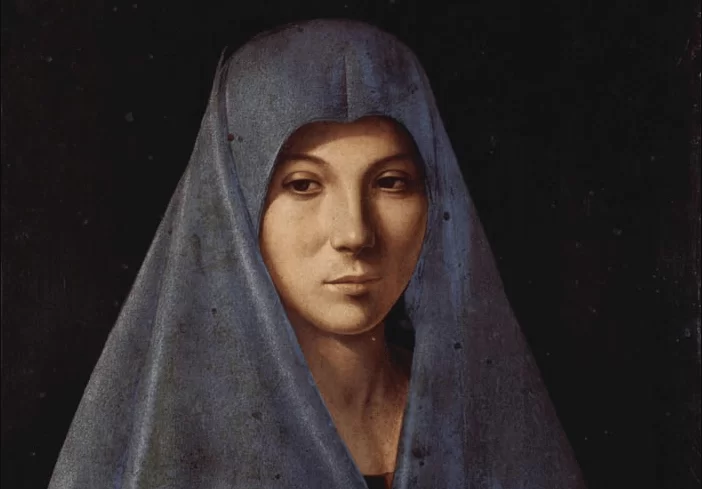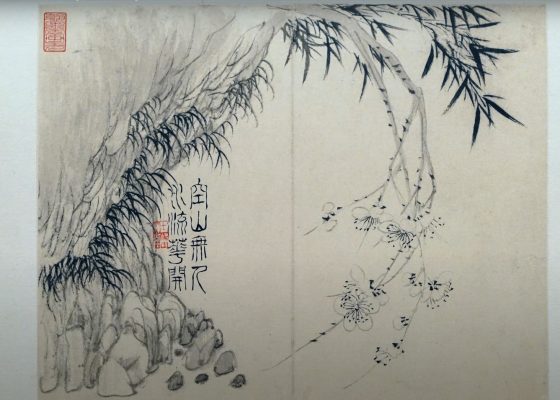
By Staff Reporter
The Virgin Annunciate is perhaps the most famous of the Sicilian painter’s works and is one of the art icons of all time, dating back to Antonello’s stay in Venice. The former enchants and surprises in its masterly orchestration of light sources, generating an interplay of backlight and, at the same time, wholly unifying the composition. But what is truly innovative is the interpretation of the Virgin Annunciate from Palermo, in which the painter achieves absolutely modern results, breaking up the traditional composition of the Annunciation scene. Here, indeed, Antonello condenses the sacred event into the single figure of the Virgin and concentrates on the personal and intimist aspect of the scene, underlining the psychological effects of the event revealed to the pensive and realistic figure of the Virgin and making the viewer feel, due to the absence of the angel, that he is the sole witness to the sacred event.
The Virgin Annunciate was created for a domestic interior. It is a haunting image of the adolescent Mary when the angel Gabriel announces to her that she will bear God’s Son. The modest Sicilian female, attired in a simple blue mantle, is aloof and mysterious. She is shown bust-length and against a plain background. Mary looks up from behind a reading desk upon which her book of devotions rests. Her direct outward gaze and right hand raised in a blessing gesture engage the viewer, who replaces Gabriel as the provider of the miraculous news and becomes an active participant in the charming painting’s story. The lack of a pendant or adjoining panel suggests that the angel’s presence is implied.

Noteworthy in The Virgin Annunciate is Antonello’s use of light to build convincing forms. To paint Mary’s foreshortened right hand, he may have employed a velo, a stringed grid through which an artist observed objects and then recorded their contours onto a squared piece of paper.
The panel is a compelling depiction of Mary with an open devotional text on a simply rendered geometric lectern. She acknowledges the implied presence of the angel Gabriel, who is about to tell her that she will be the mother of the Son of God. In response to the angel’s greeting, Mary clasps her blue cloak closed and holds it modestly in front of her chest. Meanwhile she gestures outwardly with her right hand extending beyond the picture plane’s surface to Gabriel, who occupies the viewer’s space. Some art historians feel that the foreshortened quality of the Virgin’s right hand was achieved through the use of a velo (a string grid through which shapes were observed, drawn onto a squared piece of paper and then transferred to a painting). Although the subject is religious in nature, Antonello consciously chose a young and humble Sicilian girl for the model of the Blessed Virgin. In this way, he took a theme from the remote Biblical past and made it spiritually relevant, if not awe-inspiring, to anyone who saw the painting.
Antonello da Messina (c. 1430–1479)
Antonello da Messina is one of the most pioneering and influential painters in quattrocento. Antonello di Giovanni d’Antonio was born in the seaport city of Messina, Sicily, around 1430. His formation took place in Naples during the reign of Alfonso of Aragon, in the brilliant artistic atmosphere of French and Dutch painting. Antonello absorbed these influences to the point that many of his modern people believed that he was the first to introduce oil painting in Italy-which has become popular in the north. The 16th-century writer Vasari described the life of Antonello da Messina as a story of borrowing and conversion, which is the origin myth of oil painting. The legendary inventor of oil paint is Jan van Eyck. According to Vasari, he is an alchemist and artist who discovered it after years of mysterious experiments. Despite the unique smell of his paintings, he managed to preserve his findings. Then Antonello, “a smart, lively, and extremely clever man”, happened to go to Naples and saw a painting by Van Eyck owned by King Alfonso. Antonello was so shocked that he gave up everything to go to Bruges, where he fascinated the elderly Van Eyck with gifts until he shared the secret.
Antonello established his studio in Venice, a city suitable for his enjoyment. His trip to Venice in 1475 was a landmark moment, where he redesigned the art of Giovanni Bellini and other Venetian painters for the church of San Cassiano there (now a fragmentary form of the Kunsthistorisches Museum in Vienna). His portrait marks a new stage in the evolution of the genre in Italy. Antonello’s portraits, including his portrait of a mysterious figure in the Cefalu Mandela Liska Museum in Sicily (1465), transformed his image from Flemish art to Italian art. There were no greater artists in southern Italy in the 15th century.

“The Annunciation” is probably the most famous work of the Sicilian painter and one of the artistic icons of all time. Its history can be traced back to Antonello’s stay in Venice. The former is fascinating and surprising with its clever light source arrangement, which produces the interaction of the backlight, while completely unifying the composition. But what is truly innovative is the interpretation of the Annunciation of the Virgin of Palermo, in which the painter achieves an absolutely modern effect, breaking the traditional composition of the Annunciation scene. Indeed, here, Antonello condenses the sacred event into a single image of the Virgin, focusing on the personal and private aspects of the scene, emphasizing the psychological impact of the event on the contemplative and realistic image of the Virgin, and letting the audience feel, Because of the angel’s absence, he is the only witness of the sacred event.
The Christ at the Column from the Louvre constitutes the pinnacle of Antonello’s explorations of this theme. The bold and highly original iconographic scheme conveys the sufferings of the martyred Christ in extreme close-up. Christ at the Column was intended for private devotion. The picture was painted late in Antonello’s career-but whether in Venice or Sicily is not known.












Cancel anytime


Using our website
You may use the The Middle Land website subject to the Terms and Conditions set out on this page. Visit this page regularly to check the latest Terms and Conditions. Access and use of this site constitutes your acceptance of the Terms and Conditions in-force at the time of use.
Intellectual property
Names, images and logos displayed on this site that identify The Middle Land are the intellectual property of New San Cai Inc. Copying any of this material is not permitted without prior written approval from the owner of the relevant intellectual property rights.
Requests for such approval should be directed to the competition committee.
Please provide details of your intended use of the relevant material and include your contact details including name, address, telephone number, fax number and email.
Linking policy
You do not have to ask permission to link directly to pages hosted on this website. However, we do not permit our pages to be loaded directly into frames on your website. Our pages must load into the user’s entire window.
The Middle Land is not responsible for the contents or reliability of any site to which it is hyperlinked and does not necessarily endorse the views expressed within them. Linking to or from this site should not be taken as endorsement of any kind. We cannot guarantee that these links will work all the time and have no control over the availability of the linked pages.
Submissions
All information, data, text, graphics or any other materials whatsoever uploaded or transmitted by you is your sole responsibility. This means that you are entirely responsible for all content you upload, post, email or otherwise transmit to the The Middle Land website.
Virus protection
We make every effort to check and test material at all stages of production. It is always recommended to run an anti-virus program on all material downloaded from the Internet. We cannot accept any responsibility for any loss, disruption or damage to your data or computer system, which may occur while using material derived from this website.
Disclaimer
The website is provided ‘as is’, without any representation or endorsement made, and without warranty of any kind whether express or implied.
Your use of any information or materials on this website is entirely at your own risk, for which we shall not be liable. It is your responsibility to ensure any products, services or information available through this website meet your specific requirements.
We do not warrant the operation of this site will be uninterrupted or error free, that defects will be corrected, or that this site or the server that makes it available are free of viruses or represent the full functionality, accuracy and reliability of the materials. In no event will we be liable for any loss or damage including, without limitation, loss of profits, indirect or consequential loss or damage, or any loss or damages whatsoever arising from the use, or loss of data, arising out of – or in connection with – the use of this website.
Last Updated: September 11, 2024
New San Cai Inc. (hereinafter “The Middle Land,” “we,” “us,” or “our”) owns and operates www.themiddleland.com, its affiliated websites and applications (our “Sites”), and provides related products, services, newsletters, and other offerings (together with the Sites, our “Services”) to art lovers and visitors around the world.
This Privacy Policy (the “Policy”) is intended to provide you with information on how we collect, use, and share your personal data. We process personal data from visitors of our Sites, users of our Services, readers or bloggers (collectively, “you” or “your”). Personal data is any information about you. This Policy also describes your choices regarding use, access, and correction of your personal information.
If after reading this Policy you have additional questions or would like further information, please email at middleland@protonmail.com.
PERSONAL DATA WE COLLECT AND HOW WE USE IT
We collect and process personal data only for lawful reasons, such as our legitimate business interests, your consent, or to fulfill our legal or contractual obligations.
Information You Provide to Us
Most of the information Join Talents collects is provided by you voluntarily while using our Services. We do not request highly sensitive data, such as health or medical information, racial or ethnic origin, political opinions, religious or philosophical beliefs, trade union membership, etc. and we ask that you refrain from sending us any such information.
Here are the types of personal data that you voluntarily provide to us:
As a registered users or customers, you may ask us to review or retrieve emails sent to your business. We will access these emails to provide these services for you.
We use the personal data you provide to us for the following business purposes:
Information Obtained from Third-Party Sources
We collect and publish biographical and other information about users, which we use to promote the articles and our bloggers who use our sites. If you provide personal information about others, or if others give us your information, we will only use that information for the specific reason for which it was provided.
Information We Collect by Automated Means
Log Files
The site uses your IP address to help diagnose server problems, and to administer our website. We use your IP addresses to analyze trends and gather broad demographic information for aggregate use.
Every time you access our Site, some data is temporarily stored and processed in a log file, such as your IP addresses, the browser types, the operating systems, the recalled page, or the date and time of the recall. This data is only evaluated for statistical purposes, such as to help us diagnose problems with our servers, to administer our sites, or to improve our Services.
Do Not Track
Your browser or device may include “Do Not Track” functionality. Our information collection and disclosure practices, and the choices that we provide to customers, will continue to operate as described in this Privacy Policy, whether or not a “Do Not Track” signal is received.
HOW WE SHARE YOUR INFORMATION
We may share your personal data with third parties only in the ways that are described in this Privacy Policy. We do not sell, rent, or lease your personal data to third parties, and We does not transfer your personal data to third parties for their direct marketing purposes.
We may share your personal data with third parties as follows:
There may be other instances where we share your personal data with third parties based on your consent.
HOW WE STORE AND SECURE YOUR INFORMATION
We retain your information for as long as your account is active or as needed to provide you Services. If you wish to cancel your account, please contact us middleland@protonmail.com. We will retain and use your personal data as necessary to comply with legal obligations, resolve disputes, and enforce our agreements.
All you and our data are stored in the server in the United States, we do not sales or transfer your personal data to the third party. All information you provide is stored on a secure server, and we generally accepted industry standards to protect the personal data we process both during transmission and once received.
YOUR RIGHTS/OPT OUT
You may correct, update, amend, delete/remove, or deactivate your account and personal data by making the change on your Blog on www.themiddleland.com or by emailing middleland@protonmail.com. We will respond to your request within a reasonable timeframe.
You may choose to stop receiving Join Talents newsletters or marketing emails at any time by following the unsubscribe instructions included in those communications, or you can email us at middleland@protonmail.com
LINKS TO OTHER WEBSITES
The Middle Land include links to other websites whose privacy practices may differ from that of ours. If you submit personal data to any of those sites, your information is governed by their privacy statements. We encourage you to carefully read the Privacy Policy of any website you visit.
NOTE TO PARENTS OR GUARDIANS
Our Services are not intended for use by children, and we do not knowingly or intentionally solicit data from or market to children under the age of 18. We reserve the right to delete the child’s information and the child’s registration on the Sites.
PRIVACY POLICY CHANGES
We may update this Privacy Policy to reflect changes to our personal data processing practices. If any material changes are made, we will notify you on the Sites prior to the change becoming effective. You are encouraged to periodically review this Policy.
HOW TO CONTACT US
If you have any questions about our Privacy Policy, please email middleland@protonmail.com
The Michelin brothers created the guide, which included information like maps, car mechanics listings, hotels and petrol stations across France to spur demand.
The guide began to award stars to fine dining restaurants in 1926.
At first, they offered just one star, the concept was expanded in 1931 to include one, two and three stars. One star establishments represent a “very good restaurant in its category”. Two honour “excellent cooking, worth a detour” and three reward “exceptional cuisine, worth a
Thank you for your participation,
please Log in or Sign up to Vote

123Sign in to your account